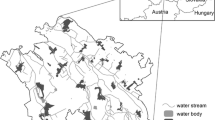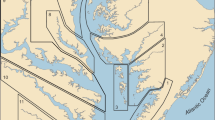Abstract
Analyses of habitat loss are often restricted to the past 75 years by the relative youth of aerial photography and remote sensing technologies. Although photographic techniques are highly accurate, they are unable to provide measurements of habitat loss prior to the 1950s. In this study, historical maps from the late 1700s and early 1800s covering portions of Rhode Islan, Massachusetts, New Hampshire, and Maine were used to approximate naturally occurring salt marsh cover in New England. Historical data was compared to current salt marsh coverage available in public geographic information system (GIS) data sets. The average loss in New England is estimated at 37% using this technique. Rhode Island has lost the largest proportion of salt marshes by state, a staggering 53% loss since 1832. Massachusetts has also experience large losses, amounting to a 41% loss of salt marsh since 1777. The Boston area alone has lost 81% of its salt marshes. Salt marsh loss was highly correlated with urban growth. Restoration and preservation efforts have resulted in the retention of salt marsh in less populated areas of New England. Although historical maps are difficult to verify, they represent an extremely valuable and underused data repository. Using historical maps to trace land use practices is an effective way to overcome the short-term nature of many ecological studies. This technique could be applied to other habitats and other regions, wherever accurate historical maps are available. Analysis of historic conditions of habitats can help conservation managers determine appropriate goals for restoration and management.
Similar content being viewed by others
Literature Cited
Agardy, T. S. 1997. Marine Protected Areas and Ocean Conservation. R. G. Landes Company and Academic Press, Austin, Texas.
Bertness, M. D. 1999. Ecology of Atlantic Shorelines. Sinauer Associates, Sunderland, Massachusetts.
Bertness, M., B. R. Silliman, andR. Jefferies. 2004. Salt marshes under siege.American Scientist 92:54–62.
Boesch, D. F. andR. E. Turner. 1984. Dependence of fishery species on salt marshes: The role of food and refuge.Estuaries 7:460–468.
Buchsbaum, R. 2001. Coastal marsh management, p. 323–350.In D. M. Kent (ed.), Applied Wetlands Science and Technology, 2nd edition. Lewis Publishers, New York.
Butlin, R. 1995. Social, economic and environmental change in the fen and fen-edge region of east Cambridgeshire in the nineteenth century, p. 146–168.In R. A. Butlin and N. Roberts (eds.), Ecological Relations in Historical Times. Blackwell Publishers, Cambridge, Massachusetts.
Costa, J. E. 1988. Distribution, production, and historical changes in abundance of eelgrass (Zostera marina L.) in southeastern M.A. Ph.D. Dissertation, Boston University, Boston, Massachusetts.
Costanza, R., R. D’Arge, R. De Groot, S. Farber, M. Grasso, B. Hannon, K. Limburg, S. Naeem, R. V. O’Neill, J. Paruelo, R. G. Raskin, P. Sutton, andM. Van Den Belt. 1997. The value of the world’s ecosystem services and natural capital.Nature 387: 253–280.
Cowardin, L. M., V. Carter, F. C. Golet, andE. T. LaRoe. 1979. Classification of Wetlands and Deepwater Habitats of the United States. Department of the Interior, U.S. Fish and Wildlife Service, Washington, D.C.
Dahl, T. E. 1990. Wetland Losses in the United States 1780s to 1980s. U.S. Department of the Interior, Fish and Wildlife Service, Washington, D.C.
Dahl, T. E. 2000. Status and Trends of Wetlands in the Conterminous United States 1986 to 1997. U.S. Department of the Interior, Fish and Wildlife Service, Washington, D.C.
Donnelly, J. P. andM. D. Bertness. 2001. Rapid shoreward encroachment of salt marsh cordgrass in response to accelerated sea-level rise.Proceedings of the National Academy of Sciences 98:14218–14223.
Dreyer, G. D. andW. A. Niering. 1995. Tidal marshes of Long Island Sound: Ecology, History, and Restoration. Connecticut College Arboretum Bulletin No. 34. Connecticut College Arboretum, New London, Connecticut.
Evans, G. N. D. 1969. Uncommon Obdurate: The Several Public Careers of J. F. W. DesBarres. Peabody Museum of Salem, Massachusetts, U.S.A. and University of Toronto Press, Toronto, Canada.
Flenley, J. R., S. M. King, J. Jackson, C. Chew, J. T. Teller, andM. E. Prentice. 1991. The late quaternary vegetational and climatic history of Easter Island.Journal of Quaternary Science 6:85–115.
Frayer, W. E., M. J. Monahan, D. C. Bowden, andF. A. Graybill. 1983. Status and Trends of Wetlands and Deepwater Habitats in the Conterminous United States, 1950’s to 1970’s. Colorado State University, Fort Collins, Colorado.
Gosselink, J. G. andR. H. Baumann. 1980. Wetland inventories: Wetland loss along the United States coast.Zeitschrift für Geomorphologie Supplementband 34:137–187.
Grossinger, R. 2001. Documenting local landscape change: The bay area historical ecology project, p. 425–442.In D. Egan and E. Howell (ed.), The Historical Ecology Handbook: A Restorationist’s Guide to Reference Ecosystems. Island Press, Washington, D.C.
Heimlich, R. andJ. Melanson. 1995. Wetlands lost, wetlands gained.National Wetlands Newsletter 17:22–25.
Heimlich, R. E., K. D. Wiebe, R. Classen, D. Gadsby, and R. M. House. 1998. Wetlands and Agriculture: Private Interests and Public Benefits. U.S. Department of Agriculture, Agricultural Economic Report No. 765. Washington, D.C.
Henry Stevens, Son and Stiles. 1937. Notes on Biographical and Bibliographical on The Atlantic Neptune. Henry Stevens, Son and Stiles, London, England.
Mitsch, W. J. andJ. G. Gosselink. 1993. Wetlands, 3rd edition. Van Nostrand Reinhold, New York.
National Wetland Newsletter. 1998. NRI to be national standard for wetland inventory.National Wetland Newsletter 3:27.
Nixon, S. W. 1982. The Ecology of New England High Salt Marshes: A Community Profile. U.S. Department of the Interior, Fish and Wildlife Service, Washington, D.C.
Pavelis, G. A. 1987. Farm Drainage in the United States: History, Status, and Prospects. U.S. Department of Agriculture. Miscellaneous Publication No. 1455. Washington, D.C.
Petry, F. E. andM. J. Somodevilla. 2000. Modeling issues for rubber-sheeting process in an object oriented, distributed and parallel environment,In R. Loganantharaj, G. Palm, and A. Moonis (eds.), Proceedings of the 13th International Conference on Industrial and Engineering Applications of Artificial Intelligence and Expert Systems: Intelligent Problem Solving: Methodologies and Approaches. Springer-Verlag, Berlin, Germany.
Reidenbaugh, T. G. 1983. Productivity of cordgrass,Spartina alterniflora, estimated from live standing crops, mortality, and leaf shedding in a Virginia salt marsh.Estuaries 6:57–65.
Roman, C. T., W. A. Niering, andR. S. Warren. 1984. Salt marsh vegetation change in response to tidal restriction.Environmental Management 8:141–150.
Russell, H. S. 1976. A Long, Deep Furrow: Three Centuries of Farming in New England. University Press of New England, Hanover, New Hampshire.
Seasholes, N. 2003. Gaining Ground: A History of Landmaking in Boston. Massachusetts Institute of Technology Press, Cambridge, Massachusetts.
Shaler, N. S. 1886. Sea-coast swamps of the eastern United States. U.S. Geological Survey, 6th Annual Report, Washington, D.C.
Shalowitz, A. L. 1964. Shore and Sea Boundaries. U.S. Department of Commerce and Coast and Geodetic Survey. Publication 10-1. Washington, D.C.
Silliman, B. R. andA. Bortolus. 2003. Underestimation ofSpartina productivity in western Atlantic marshes: Marsh invertebrates eat more than just detritus.Oikos 101:549–554.
Soule, M. E. 1991. Conservation: Tactics for a constant crisis.Science 253:744–750.
Stilgoe, J. R. 1994. Alongshore. Yale University Press, New Haven, Connecticut.
Teal, J. andM. Teal. 1969. Life and Death of the Salt Marsh. Atlantic Monthly Press, Boston, Massachusetts.
Tiner, R. 1996. Wetland definitions and classifications in the United States,In J. D. Fretwell, J. S. Wiliams, and P. J. Redman (eds.), National Water Summary on Wetland Resources. Water Supply Paper 2425, U.S. Geological Survey, Washington, D.C.
Tiner, R. W. 2003. Correlating Enhanced National Wetlands Inventory Data with Wetland Functions for Watershed Assessments: A Rationale for Northeastern U.S. Wetlands. U.S. Fish and Wildlife Service, Hadley, Massachusetts.
Turner, R. E. 1977. Intertidal vegetation and commercial yields of penaeid shrimp.Transactions of the American Fisheries Society 106:411–416.
U.S. Fish and Wildlife Service, National Wetland Inventory. 2002. A Strategy for the 21st Century, U.S. Fish and Wildlife Service, National Wetland Inventory, Washington, D.C.
U.S. Government Printing Office (USGPO). 1990. Public Papers of the Presidents of the United States: George Bush. 1989: Book I. Washington, D.C.
Van Dyke, E. andK. Wasson. 2005. Historical ecology of a central California estuary: 150 years of habitat change.Estuaries 28:173–189.
Watzin, M. C. 1992. The Fragile Fringe: Coastal Wetlands of the Continental United States. Sea Grant, U.S. Fish and Wildlife Service and National Oceanic and Atmospheric Administration, Washington, D.C.
Willis, K. J., L. Gillson, andT. M. Brncic. 2004. How “virgin” is virgin rainforest?Science 304:402–403.
Wright, J. O. 1907. Swamp and Overflowed Lands in the United States. U.S. Department of Agriculture, Circular No. 76. Washington, D.C.
Zedler, J. B. andR. Lindig-Cisneros. 2000. Functional equivalenty of restored and natural salt marshes, p. 565–582.In M. P. Weinstein and D. A. Kreeger (eds.), Concepts and Controversies in Tidal Marsh. Kluwer Academic Publishers, Boston, Massachusetts.
Source of Unpublished Materials
Pesch, C. personal communication. U.S. Environmental Protection Agency, Environmental Effects Research Laboratory, Atlantic Ecology Division, 27 Tarzwell Drive, Narragansett, Rhode Island 02882.
Author information
Authors and Affiliations
Corresponding author
Rights and permissions
About this article
Cite this article
Bromberg, K.D., Bertness, M.D. Reconstructing New England salt marsh losses using historical maps. Estuaries 28, 823–832 (2005). https://doi.org/10.1007/BF02696012
Received:
Revised:
Accepted:
Issue Date:
DOI: https://doi.org/10.1007/BF02696012




